OUC has planted solar trees at key sites across our service area. The trees are fully functional solar structures that we are using to enrich and educate our customers on the unique benefits of solar power. OUC has recently been ranked as being one of the most solar-friendly utilities in the state for good reason. OUC is offering some new innovative programs that will increase the use of solar in a part of the country that is blessed with abundant sunshine.
OUC has also invested in solar on bus shelters, solar on utility poles and has been an area leader in installing utility-scale projects atop the Orange County Convention Center and at our Stanton Energy Center. Solar energy has also been used to offset some of the needs of one of the most advanced Electric Vehicle (EV) infrastructures in the southeast. OUC has helped install more than 150 EV charging stations.
OUC has also partnered with the City of Orlando and placed H2OUC hydration stations throughout the city at our parks, community centers and neighborhood centers.

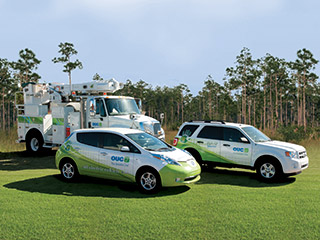 Driving Innovation
Driving Innovation
With nearly 1,000 vehicles – ranging from plug-in hybrids to bucket trucks – OUC’s fleet logs more than 4.7 million miles annually. So, on the road to reducing our carbon footprint, we’re using alternative fuels, purchasing more hybrids and even recycling automotive products to help our environment.
Fuel-Efficient Vehicles
Embracing fuel-efficient technology as a commitment to green initiatives, OUC was the first municipal utility in Florida to acquire a plug-in hybrid that gets up to 99 mpg.
To support our fleet and the needs of our customers, OUC has installed more than 150 electric vehicle (EV) charging stations in our service area and has innovative rebate options for both residential and commercial customers to install more.
For our linemen out in the field, we have several hybrid bucket trucks and an auxiliary battery system to operate the aerial tower hydraulics. Bucket trucks are a promising application for hybrid technology since much of the vehicle’s work is done when stationary. The hybrid diesel-electric system allows the main engine to be turned off while crews operate entirely off the battery.
Adding New Fuels to the Mix
As part of an overall plan to reduce emissions in our fleet, OUC is using “B20” – a blend of 80 percent petroleum diesel and 20 percent biodiesel – a clean-burning alternative fuel made from new or used vegetables oils and animal fats, including recycled cooking grease. Compared to petroleum diesel, biodiesel produces lower emissions, which is better for the environment. B20 has been integrated seamlessly into our fueling system without any changes to vehicles or fuel storage and distribution equipment.
Environmentally Friendly Policies
OUC’s Fleet Division has incorporated a number of eco-conscious policies. We use earth-friendly products and take special care to dispose of contaminated fuels according to environmental standards. Tires, batteries and oil filters are recycled through vendors, while Freon, antifreeze and motor oil are handled on site. OUC recycles about 20,000 gallons of used oil each year.
We also have a vehicle idling policy that requires the engine to be turned off after five minutes. Diesel engines use about one gallon of fuel per hour when idling, so this policy saves about $4 per hour per vehicle.
Water is recycled, too – thanks to mini-water treatment plants and wash racks at the Pershing and Gardenia facilities that keep OUC vehicles clean.
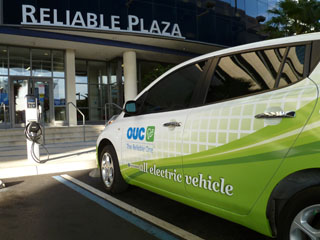 With the sale of plug-in electric vehicles (EV) rising across the nation, OUC has ensured that Orlando is ready for them. Since 2010, we have installed hundreds of public charging stations as part of Project Get Ready, a collaboration between the industry and government to promote the EV movement, and helped make Orlando a national leader in electric transportation and reduce greenhouse gases (GHG) emissions.
With the sale of plug-in electric vehicles (EV) rising across the nation, OUC has ensured that Orlando is ready for them. Since 2010, we have installed hundreds of public charging stations as part of Project Get Ready, a collaboration between the industry and government to promote the EV movement, and helped make Orlando a national leader in electric transportation and reduce greenhouse gases (GHG) emissions.
OUC’s own fleet of EVs are used for service calls and showcased at community events for educational purposes. So while they’re counseling customers on how to make their homes and businesses more efficient, conservation specialists are walking the walk, or rather driving the drive, when it comes to efficiency.
Plug-In Ready
As part of OUC’s commitment to alternative fuels and efficient transportation, several electric-vehicle charging stations at Reliable Plaza are powered by the sun. Located in our parking garage, the 16-panel solar array provides a total of 2.8 kilowatts of power to charge the vehicles. The garage has been pre-wired for two more stations that can be connected to OUC power as we add more electric cars to our fleet. At night or on a cloudy day when the sun is not shining, the power is drawn from Reliable Plaza. And when the sun is shining but no car is charging, the power is fed back into the building.
OUC can access a special website to track real-time information and total system usage for its charging stations. At 208V or 240V, a full charge takes about four hours. OUC has installed several Direct Current (DC) Fast Chargers in Orlando, which charge up to 80 percent of an EV's battery capacity in 30 minutes or less. Plug-in drivers can go to mychargepoint.com to locate available charging stations nationwide. Users register with Chargepoint to set up an account that links to their credit card or key fob. The cost for the power is billed by Chargepoint.
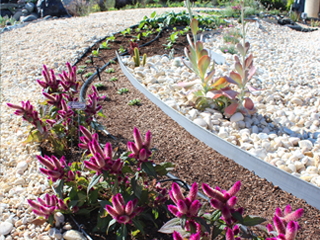 A closed customer service drive-thru at OUC’s Gardenia facility was repurposed with a Living Wall and Rain Harvest Garden. This sustainability feature combines conservation and aesthetics, using Florida-friendly plants and self-sufficient gardening practices to reduce water use and encourage wellness.
A closed customer service drive-thru at OUC’s Gardenia facility was repurposed with a Living Wall and Rain Harvest Garden. This sustainability feature combines conservation and aesthetics, using Florida-friendly plants and self-sufficient gardening practices to reduce water use and encourage wellness.
Rain Harvest Garden
The sustainable Rain Harvest Garden is a hybrid garden that has a minimal impact on the environment and works in harmony with nature. The strategically placed plants allow for the creation of pollinators and attractors for butterflies, bees and birds – all while allowing for natural pest and disease mitigation. Additionally, the garden is full of edible plants like herbs, seeds and berries and that can be eaten. Edible plants are higher in nutrients than those that travel thousands of miles to get to the grocery store.
The sustainable gardens is self-sufficient and includes all of the following:
- Plant Conservation (Healthy, Florida-Friendly Plants That Thrive)
- Water Conservation (Rain Harvesting, Low-Volume Irrigation, Drought-Tolerant Plants)
- Energy Conservation (Low-Energy Input Systems)
- Hyper-Local Food & Medicine (Food Foraging Plants for Animals and Insects, Edible Plants, Medicinal Plants)
- Aesthetics and Mental Wellbeing (Beautification, Garden as Therapy, Meditation)
The below diagram explains the water cycle through the garden.
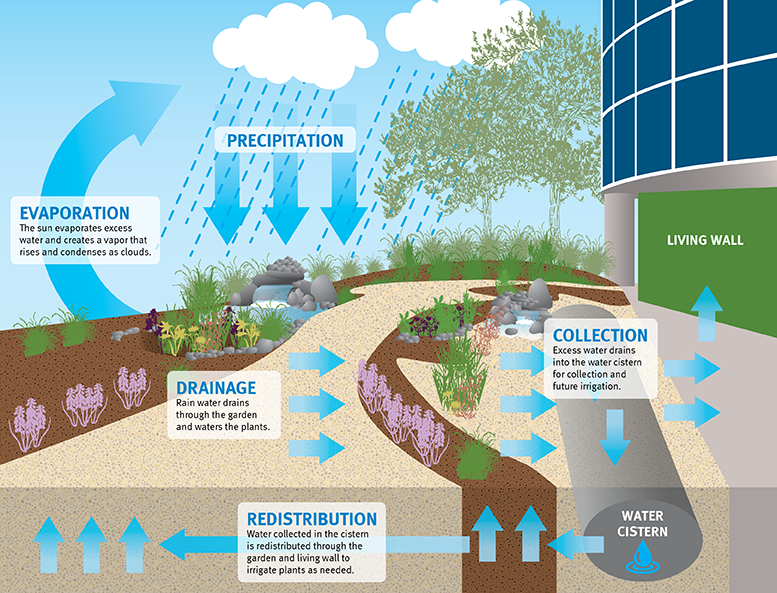
Living Wall
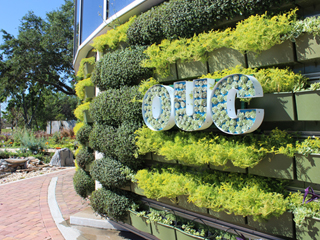 The Living Wall is just one way OUC embraces sustainability to ensure a greener future. During each season, the wall is refreshed with seasonal edible plants and Florida-friendly and drought-tolerant plants. Plants are strategically placed (or companion planted) so they are stronger and can thrive, while also allowing for pest and disease mitigation, creation of pollinators and attractors for butterflies, bees and birds. Edible and medicinal plants are located on one side of the wall, and Florida-friendly and drought-tolerant succulent plants fill in the rest.
The Living Wall is just one way OUC embraces sustainability to ensure a greener future. During each season, the wall is refreshed with seasonal edible plants and Florida-friendly and drought-tolerant plants. Plants are strategically placed (or companion planted) so they are stronger and can thrive, while also allowing for pest and disease mitigation, creation of pollinators and attractors for butterflies, bees and birds. Edible and medicinal plants are located on one side of the wall, and Florida-friendly and drought-tolerant succulent plants fill in the rest.